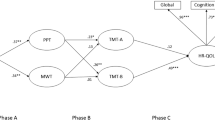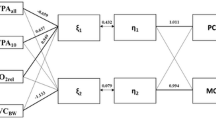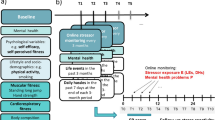Abstract
Background: Self-efficacy has been shown to be both an antecedent and determinant of behaviors such as physical activity and may explain variance in the performance of functional tasks among older adults.Purpose: The objectives of the current study were: first, to identify potential latent factors of functional fitness (i.e., the ability to perform activities of daily living) among older adults; and second, to determine the extent to which self-efficacy contributed to the variance in functional fitness over and above other known correlates.Methods: Older adults (n = 190, M age = 69.4 years) completed a functional fitness test battery, maximal graded exercise test, and demographics and self-efficacy questionnaires.Results: Structural equation modeling supported two latent factors of functional fitness representing “Flexibility” and “Physical Power.” Further analyses indicated sex as the sole significant correlate of Flexibility. Greater Physical Power was associated with being male, younger, and having higher self-efficacy.Conclusions: These results support the role of self-efficacy as a correlate of performance on functional tasks. Targeting flexibility and physical power to improve functional fitness among older men and women, respectively, warrants examination.
Similar content being viewed by others
References
Arbuckle, J. L. (1996). Full information estimation in the presence of incomplete data. In G. A. Marcoulides & R. E. Schumacker (Eds.),Advanced structural equation modeling: Issues and techniques (pp. 243–278). Mahwah, NJ: Lawrence Erlbaum.
Bandura, A. (1997).Self-efficacy: The exercise of control. New York: W. H. Freeman.
Bentler, P. M. (1990). Comparative fix indexes in structural models.Psychological Bulletin, 107, 238–246.
Bentler, P. M., & Bonett, D. G. (1980). Significance tests and good- ness of fit in the analysis of covariance structures.Psychological Bulletin, 88, 588–606.
Bollen, K. A. (1989).Structural equations with latent variables. New York: John Wiley & Sons.
Centers for Disease Control and Prevention. (2006).National vital statistics reports. Retrieved June 2, 2006, from http://www. cdc.gov/nchs/nvss.htm
Daley, M. J., & Spinks, W. L. (2000). Exercise, mobility, and aging.Sports Medicine, 29(1), 1–12.
Enders, C. K. (2001). The impact of nonnormality on full information maximum-likelihood estimation for structural equation models with missing data.Psychological Methods, 6, 352–370.
Enders, C. K., & Bandalos, D. L. (2001). The relative performance of full information maximum likelihood estimation for missing data in structural equation models.Structural Equation Modeling, 8, 430–457.
Evans, W. J. (1995). What is sarcopenia?Journal of gerontology: Biological and medical sciences, 50(Spec), 5–8.
Gill, T. M., Williams, C. S., Richardson, E. D., & Tinetti, M. E. (1996). Impairments in physical performance and cognitive status as predisposing factors for functional dependence among nondisabled older persons.Journals of Gerontology Series A: Biological Sciences & Medical Sciences, 51(6), 283–288.
Guralnik, J. M., Ferrucci, L., Simonsick, E. M., Salive, M. E., & Wallace, R. B. (1995). Lower extremity function in persons over the age of 70 years as a predictor of subsequent disability.New England Journal of Medicine, 332(2), 556–561.
Hruda, K. V., Hicks, A. L., & McCartney, N. (2003). Training for muscle power in older adults: Effects on functional abilities.Canadian Journal of Applied Physiology, 28(2), 178–189.
Hu, L., & Bentler, P. M. (1999). Cutoff criteria for fit indices in covariance structure analysis: Conventional versus new alternatives.Structural Equation Modeling, 6, 1–55.
Hui, S. S., & Yuen, P. Y. (2000). Validity of the modified back-saver sit-and-reach test: A comparison with other protocols.Medicine and Science in Sports and Exercise, 32, 1655–1659.
Janssen, I., Heymsfield, S. B., Wang, Z. M., & Ross, R. (2000). Skeletal muscle and distribution in 468 men and women aged 18-88 years.Journal of Applied Physiology, 89, 81–88.
Kiecolt-Glaser, J. K., McGuire, L., Robles, T. F., & Glaser, R. (2002). Emotions, morbidity, and mortality: New perspectives from psychoneuroimmunology.Annual Review of Psychology, 53, 83–107.
Lawrence, R. H., & Jette, A. M. (1996). Disentangling the disablement process.Journals of Gerontology Series B: Psychological Sciences & Social Sciences, 51B(4), S 173–182.
Lexell, J., Taylor, C. C., & Sjostrom, M. (1988). What is the cause of muscle atrophy?Journal of the Neurological Sciences, 84(2-3), 275–294.
McArdle, W., Katch, F., & Katch, V. (2001).Exercise physiology: Energy, nutrition, and human performance (5th ed.). Philadelphia: Lippincott, Williams, and Wilkins.
McAuley, E. (1993). Self-efficacy and the maintenance of exercise participation in older adults.Journal of Behavioral Medicine, 16, 103–113.
McAuley, E., & Blissmer, B. (2000). Self-efficacy determinants and consequences of physical activity.Exercise and Sport Science Reviews, 28(2), 85–88.
McCartney, N., Hicks, A. L., Martin, J., & Webber, C. E. (1996). A longitudinal trial of weight training in the elderly: Continued improvements in year 2.Journals of Gerontology Series A: Biological Sciences & Medical Sciences, 51 A, B425-B433.
Muthen, L. K., & Muthen, B. O. (1998-2004). Mplus (Version 3.0). Los Angeles: Muthen & Muthen.
Nagi, S. Z. (1965). Some conceptual issues in disability and rehabilitation. In M. B. Sussman (Ed.),Sociology and rehabilitation (pp. 100–113). Washington, DC: American Sociological Association.
Nagi, S. Z. (1991). Disability concepts revisited: Implications for prevention. In A. M. Pope & A. R. Tarlov (Eds.),Disability in America: Toward a national agenda for prevention (pp. 309–327). Washington, DC: National Academy Press.
Pfeiffer, E. (1975). A short portable mental status questionnaire for the assessment of organic brain deficit in elderly patients.Journal of American Geriatrics Society, 23(10), 433–441.
Rejeski, W. J., Brawley, L. R., & Haskell, W L. (2003). The prevention challenge: An overview of this supplement.American Journal of Preventive Medicine, 25, 107–109.
Rejeski, W J., Craven, T., Ettinger, W H., McFarlane, M., & Shumaker, S. (1996). Self-efficacy and pain in disability with osteoarthritis of the knee.Journal of Gerontology: Psychological Sciences, 51B, P24-P29.
Rikli, R. E., & Jones, C. J. (1997). Assessing physical performance in independent older adults: Issues and guidelines.Journal of Aging and Physical Activity, 5, 244–261.
Rikli, R. E., & Jones, C. J. (1999). Development and validation of a functional fitness test for community-residing older adults.Journal of Aging and Physical Activity, 7, 129–161.
Rikli, R. E., & Jones, C. J. (2001).Senior fitness test manual. Champaign, IL: Human Kinetics.
Roach, K. E., & Miles, T. P. (1991). Normal hip and knee active range of motion: The relationship to age.Physical Therapy, 71, 656–665.
Rodin, J. (1986). Aging and health: Effects of the sense of control.Science, 233, 1271–1276.
Rudy, T. E., Lieber, S. J., Boston, J. R., Gourley, L. M., & Baysal, E. (2003). Psychosocial predictors of physical performance in disabled individuals with chronic pain.Clinical Journal of Pain, 19(1), 18–30.
Siela, D. (2003). Use of self-efficacy and dyspnea perceptions to predict functional performance in people with COPD.Rehabilitation Nursing, 28(6), 197–204.
Steffen, T. M., Hacker, T. A., & Mollinger, L. (2002). Age- and gender-related test performance in community-dwelling elderly people: Six-Minute Walk Test, Berg Balance Scale, Timed Up- & -Go Test, and gait speeds.Physical Therapy, 82(2), 128–137.
Svenningsen, S., Terjesen, T., Auflem, M., & Berg, V. (1989). Hip motion related to age and sex.Acta Orthopaedica Scandinavica, 60, 97–100.
Walker, J. M., Sue, D., Miles-Elkousy, N., Ford, G., & Trevelyan, H. (1984). Active mobility of the extremities in older subjects.Physical Therapy, 64, 919–923.
Author information
Authors and Affiliations
Corresponding author
Additional information
This study was funded by grants from the National Institute on Aging (#AG-12113, #AG-18008) and the Institute for the Study of Aging (#2000035).
Rights and permissions
About this article
Cite this article
Konopack, J.F., Marquez, D.X., Hu, L. et al. Correlates of functional fitness in older adults. Int. J. Behav. Med. 15, 311–318 (2008). https://doi.org/10.1080/10705500802365557
Issue Date:
DOI: https://doi.org/10.1080/10705500802365557




